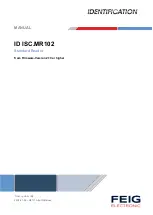
18
3
AVB Networking Basics
3.3
Choosing the Right Cables
StudioLive™ Series III
AVB Networking Guide
•
S/FTP. This cable features an overall braided screen (S) encasing foil-
screened twisted pairs (FTP). In this design, each twisted pair is protected
by its own foil screen to limit the amount of crosstalk between them.
•
F/FTP. In this design, an overall foil screen (F) protects
individually wrapped foil-screen twisted pairs (FTP).
•
U/FTP. This design removes the overall screen and relies only on the
individual foil-wrapped twisted pairs (FTP) to limit interference.
Unshielded twisted pair (UTP) and its cousins, U/FTP and F/UTP are lighter
weight and more flexible. These cable types have the benefit of being easier
to terminate and much more flexible than their shielded counterparts.
What type of cable you select depends largely on your application and the
amount of environmental interference you anticipate encountering.
3.3.3
Solid-core vs. Stranded
Another thing to keep in mind when selecting Ethernet cable is whether it
is solid- or stranded-core. In a solid-core cable, each of the conductors is a
single copper wire, which is a better fit for installations and long cable runs
(more than 70m). Stranded-core cables use multiple, thinner copper wires
for each conductor, making them more flexible and easier to handle. This
makes stranded-core cable a better fit for touring and shorter cable runs.
Most Ethernet cable is solid-core, constructed using solid
insulated bare copper conductors for each of the eight wires
in the four twisted pairs of the cable. These cables are meant
to be used in permanent and semi-permanent installations,
and are designed for longer distance horizontal and
backbone cable runs. All CAT5e and CAT6 solid UTP cables
are designated with a minimum bend radius for performance
standards. The bend radius is the minimum radius a cable
can be bent without kinking it, which can lead to damage
and shorten its life. The minimum bend radius for Category 5,
5e, and 6 cable is four times the cable diameter, or about one
inch. Proper cable installation is essential in order to
maximize the performance of the cable.
In the case of a mobile live sound operation, with frequent setup and teardown,
solid-core Ethernet cable probably isn’t the best choice, as it’s generally stiffer and
not conducive to easy layout and flat deployment runs. Solid-core cables should not
be over-flexed, bent, or twisted beyond the cable’s recommended specifications,
as you risk damaging the cable, causing it to underperform or even fail.
Stranded Ethernet cables have multiple strands (typically 7 strands per
conductor) of insulated bare copper conductors. These cables are typically
used for patch cords/cables connecting devices to the network, but because
these cables are more flexible than solid conductors, they are an excellent
choice for portable uses and applications where repeated flexing is common,
such as frequent setup and teardown of a live sound PA system.
A Quick Note About Tactical Ethernet Cable
When you need Ethernet cable that is intended specifically for harsh environments
with repeated deployment, a special type of cable should be considered. Tactical
cable generally uses stranded-wire construction for flexibility and durability,
as well as employing a heavy, often rubberized outer jacket in addition to the
lightweight PVC jacket (sometimes referred to as “up-jacketed”). Tactical Ethernet
cable has a very similar feel and handling characteristics to balanced audio
cable, and is much more rugged than common solid-core cable used for in-wall
building installation, making it ideal for Pro Audio and Live Sound applications.
Inside your Ethernet cable
Solid core
Stranded
















































